
Nara celebrated its 1300th anniversary in 2010 and is located in the prefecture of the same name in the Kansai region. The city is constantly in the shadow of its more famous “neighbour” Kyoto. However, Nara is home to a large number of significant historical sites and presents its sights with much more appeal than Kyoto.
Nara, with its eight UNESCO World Heritage Sites, is the second most important cultural heritage in Japan.
Entertainment and attractions in Nara
Most attractions, including temples and shrines, are located in Nara Park. It is also home to over 1,200 wild spotted deer which were previously considered divine messengers. After World War II, deer were officially stripped of their divine status and revered as a national treasure.
Nara Park stretches at the foot of Mount Wakakusa, founded back in 1880. In the park, you can see the largest wooden building in the world (57 m) – Todai-ji Temple (8th century) and a UNESCO World Heritage Site – with the Daibutsu-den hall, which houses one of the biggest Buddha statues in the world (14, 98 m). It is also worth paying attention to two UNESCO World Heritage Sites – the Kasuga-Taisha Shinto shrine (8th century) with its adjacent forest and the Kofuku-ji temple with three golden pavilions (8th century). The Shin-Yakushi-ji temple (8th century) and the Nara National Museum have a collection of Buddhist art, including sculptures, paintings and temple manuscripts, are also located here.
In addition to those already listed, the cultural monuments of Ancient Nara declared by UNESCO include three more Buddhist temples – Gango-ji (6th century), Yakushi-ji (7th century) and Toshodai-ji (8th century), as well as the Heijo Palace, which used to serve Imperial residence.
